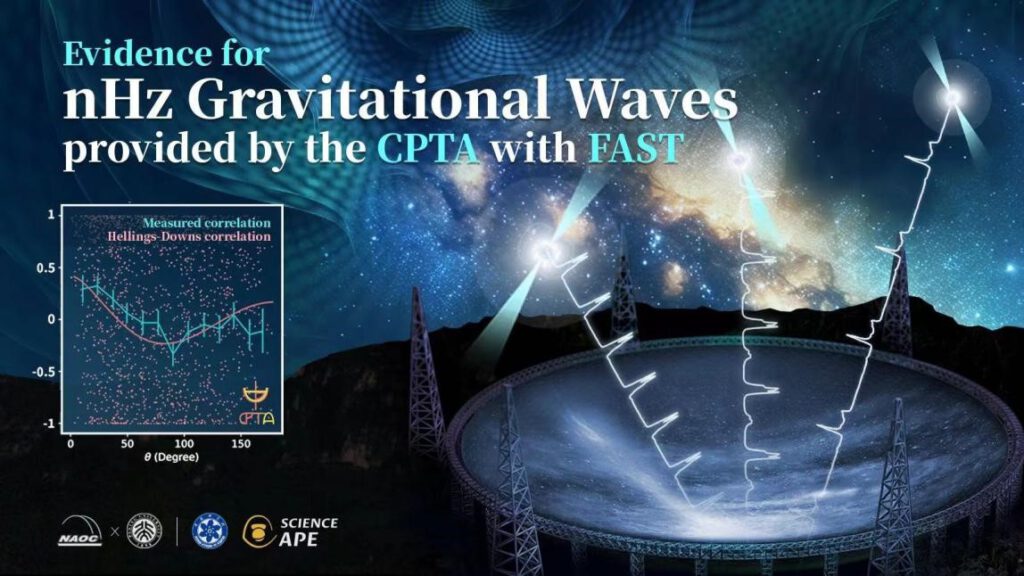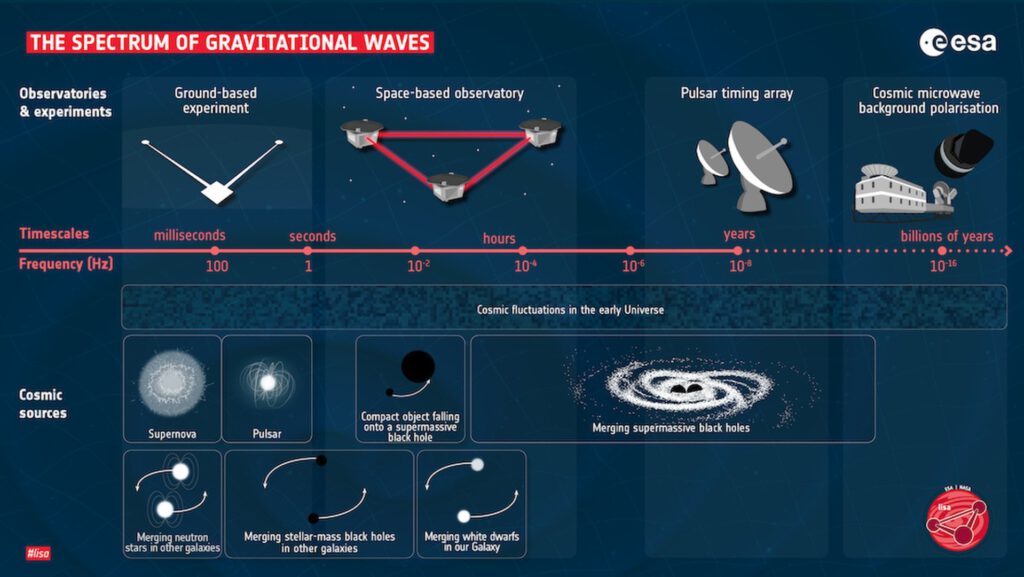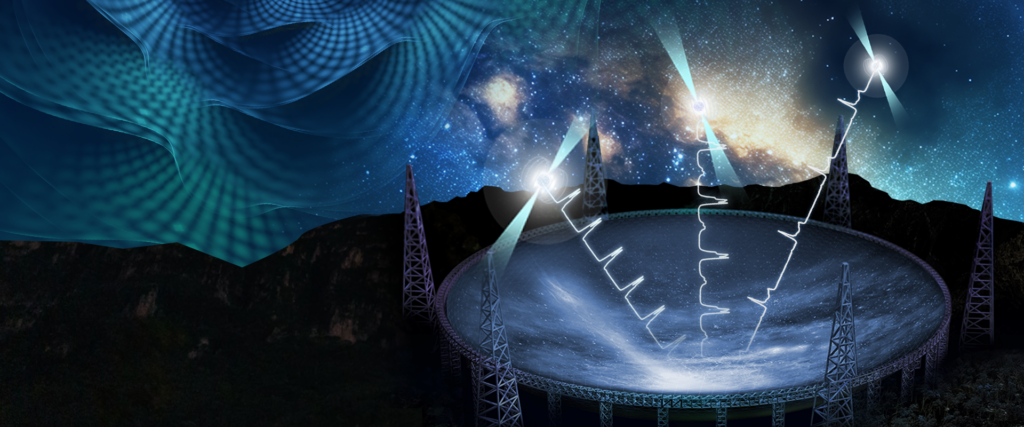
On June 29, the four teams of the China Pulsar Timing Array (CPTA), the North American Nahertz Gravitational-Wave Observatory (NANOGrav), the European Pulsar Timing Array (EPTA), and the Australian Parkes Pulsar Timing Array (PPTA) independently announced the detection of evidence of the existence of nanohertz gravitational waves, opening a new era of low-frequency gravitational wave research in astronomy.
It seems that the universe is eternally static, but it is extremely noisy. The universe is full of cosmic rays, electromagnetic waves, neutrinos, and gravitational waves. Among them, gravitational waves are essentially ripples in the curvature of space-time, and how to detect them has always been a difficult problem in the scientific community.

Special whisper from the universe
The gravitational wave was detected in 2015, and it is an instantaneous high-frequency gravitational wave with wavelengths of about tens to hundreds of kilometers, so it can be measured by a laser interferometry system with a length of about several kilometers on the ground.
But the low-frequency gravitational wave background captured by China this time is very special. Their wavelengths are tens of light-years long, and any ground-scale detectors cannot perceive their signals.
In addition to the huge difference in wavelength, compared with high-frequency gravitational waves, the fluctuation period of a wave of low-frequency gravitational waves is also very long. Even if it traveled at the speed of light, it would take years or even decades to travel the length of one wavelength. This leads to the fact that the measurement accuracy is extremely dependent on the measurement period.
Surprisingly, China’s CPTA used the powerful Five-hundred-meter Aperture Spherical Telescope (FAST) to observe the pulsar data and found the characteristic signal it wanted to observe in only three years and five months, and the false positive rate is less than 1 in 500,000.

Using pulsars to listen the story of universe
The only known way to detect low-frequency gravitational waves is to use millisecond pulsars. A pulsar is a very exotic type of neutron star that has an extremely strong magnetic field and spins steadily at high speed. The strong magnetic field causes the pulsar to produce radiation beams that sweep across the Earth periodically and quickly, and its regularity is almost comparable to the stability of an atomic clock, so it can be called a “cosmic timer”.
If the fabric of space-time between Earth and the pulsar is distorted by gravitational waves, the pulsar signal must have arrived earlier or later than expected. Scientists can therefore detect gravitational waves by measuring changes in the arrival times of pulsar signals, known as pulsar chronometry.
Since the changes in the space-time structure caused by low-frequency gravitational waves are extremely weak, and their periods are several years long, the physical scale and time scale of detecting pulsar arrays need to be very large.
For example, NANOGrav, which started the project earlier, took more than 15 years to collect data from 68 pulsars and build a huge pulsar timing array. They turned the Milky Way into a gigantic gravitational-wave antenna, which they continue to observe relentlessly.

Advantages of China’s FAST
Pulsars are very weak radio sources, so it is not easy to find a suitable pulsar that can guarantee the accuracy of the collected timing data. With the improvement of telescope observation technology, the iteration of data analysis technology, and the progress of theoretical prediction, NANOGrav in North America, EPTA in Europe, and PPTA in Australia respectively used their large radio telescopes to analyze the pulsar timing data accumulated over 20 years. Only then did evidence for the existence of low-frequency gravitational waves be found. China’s CPTA officially began searching for nanohertz gravitational waves in September 2019.
The characteristics of nanohertz gravitational waves determine that the longer the observation period, the higher the sensitivity of capturing gravitational waves. The observation period of CPTA is much smaller than that of the North American, European, and Australian teams, but the advantages of FAST make up for the huge gap.
China’s FAST is the world’s largest single-aperture and most sensitive radio telescope. The precision of the pulsar timing data collected by it is extremely high, is 4 to 50 times smaller than that of other international observation teams, which can greatly reduce the impact of measurement errors on the detection results of gravitational waves. And FAST’s high sensitivity makes it exceptionally good at detecting pulsars.

Finding the cosmic “bassist”
In the live broadcast of NANOGrav announcing the observation results, scientists compared the entire universe to a concert hall, and the two supermassive black holes (100 million to 100 billion times the mass of the sun) orbiting each other in close orbits may be the “bassist” in a “symphony orchestra”. These black holes, they think, play deep bass notes — low-frequency nanohertz gravitational waves that weave into the background bass in the cosmic “symphony”. And this is currently the most common speculation in the scientific community on the source of low-frequency gravitational waves.
In the gravitational waves in the nanohertz frequency band, there may not only be potential “bassist” black holes, but also other low-frequency instruments. Some theoretical physicists have proposed that cosmic strings—the one-dimensional topological breaches left behind by the universe’s phase transitions—could be connected into loops that then vibrate to emit low-frequency gravitational waves. Some scientists speculate that the primordial black holes formed in the early universe may also produce low-frequency gravitational waves when they merge.
However, all possibilities are only theoretical speculations and need to be considered very carefully. Scientists are desperately hoping to pick out isolated “notes” from these low-frequency background sounds, perhaps supermassive binary black hole systems close enough to our galaxy that their signals should emerge from the background signal to reveal the secrets of the universe.
(Source: people’s daily, Chinese academy of sciences, south china morning post)



